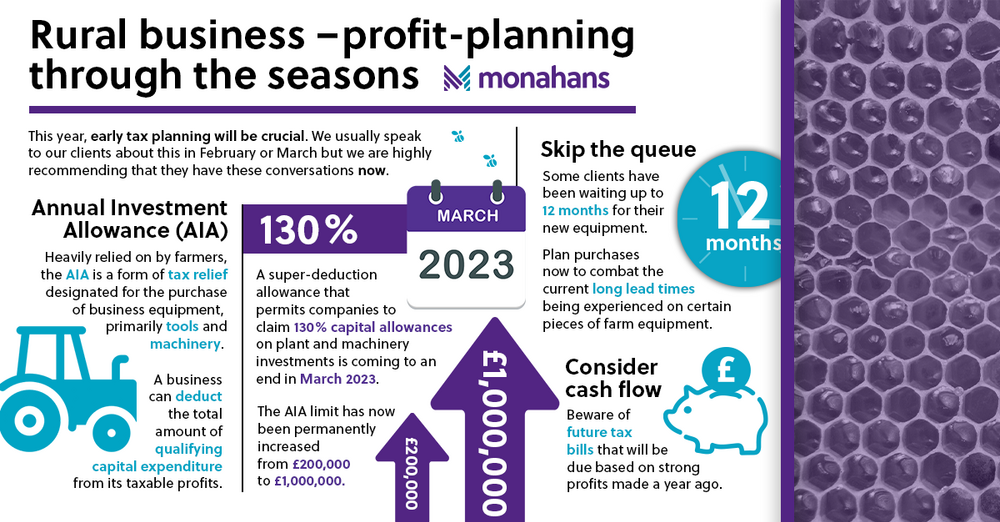27 Sep 2022
Profit-planning to weather the seasons

Many of our current conversations with clients are centred around account management and tax planning for the year-end. Looking back, certainly for farmers and rural businesses, it has been a relatively strong year. The farming cycle relies on crops being bought about 18 months in advance of harvest, which last summer meant they were available at a much better price than they are currently. Not only did these businesses receive good prices for their crops, but the yields were also healthy, culminating in a strong year for this sector.
Last year we also saw rural businesses who were able to diversify their offering, benefit heavily. For example, those able to branch into the tourism trade, were able to take advantage of various tax reliefs and tap into increased demand for services due to the surge of domestic holidaymakers. So much so, that despite initial concerns, many were not reliant on the reliefs to thrive.
A look ahead
This year, for some it’s looking very strong, others possibly less so. Weather-dependent industries have experienced a more mixed bag, as the population avoided going out and spending money in the extreme heat. But for farming, a largely positive picture is forming. Good weather over the summer improved crop growth and the recent rain will have eased the planting season, so the sector could be set to have an even better year than the last.
The heat had the potential to impact fine balance needed of crops dry enough to store but not so dry as to impact weight, but any potential repercussions have been offset by increased prices. However, it will be interesting to see how increased extreme weather may shape practices in the future.
Early bird catches the worm
Early tax planning is always beneficial but this year it will be crucial. In ordinary times we would be speaking with clients about this in February or March but this year we are highly recommending that clients should be having these conversations now. This advice is largely fuelled by the implications of incoming tax changes such as those around Annual Investment Allowance (AIA).
One area we are often discussing with client is the timing of capital expenditure and the Annual Investment Allowance (AIA).
Heavily relied on by farmers, the AIA is a form of tax relief designated for the purchase of business equipment. It allows a business to deduct the total amount of qualifying capital expenditure up to a certain limit from its taxable profits in a given tax year and is reserved for the purchase of business equipment, primarily tools and machinery. It has now been confirmed that this will be permanently set at £1,000,000 which is great news for rural businesses and allows much greater certainty around tax planning.
The super-deduction allowing companies to claim 130% capital allowances on plant and machinery investments that would usually qualify for 18% tax relief, is also coming to an end in March 2023. The breakdown is that a company investing £100,000 could claim a deduction of £130,000 against taxable profits, saving up to 19% – or £24,700 on its corporation tax bill.
Even if the allowance and limits are extended, there will be a tricky time of transitional rules over that period. So, looking ahead now and building any potential ramifications into your forecasting will be key to ensuring that you do not get caught unawares.
Skip the queue
The opportunity to plan now rather than waiting until later in the year may also be beneficial to combat the long lead times being experienced on certain pieces of farm equipment. It may still be possible to buy something smaller in a tighter timeframe but, for those looking to purchase more substantial equipment, this may prove more challenging. We’ve heard cases of certain clients waiting up to 12 months for a piece of equipment, so if there is something specific required, you’ll certainly have more chance of purchasing it now than you would later in the year.
During the pandemic, we saw businesses shying away from investing as heavily in capital equipment. But as the business landscape begins to return to a new normal, this will likely change, dependent on tax considerations. For example, many may be looking to take advantage of the current AIA, but if there are issues with delays or if the timing of the tax refund release available is much slower, this may impact which tax year is affected. As timing can vary, the key is to ensure that this possibility is factored into any plans.
Cash flow is another consideration. Our clients have given us the impression that cash is currently presenting less of a challenge as a result of several factors coming together at once, such as the government accelerating the payment of subsidies to assist with farmer’s cash flows. However, it’s worth factoring in that when big tax bills based on strong profits made a year ago eventually become due, the market could be looking very different.
No matter what is thrown at you, planning is key. A financial specialist will be able to help you to factor upcoming changes into your forecasting and forward planning, as well as helping you to navigate tax changes.
If you need support with your profit planning, please get in touch with me or one of my colleagues today, and we’d be more than happy to help.
Andrew Perrott